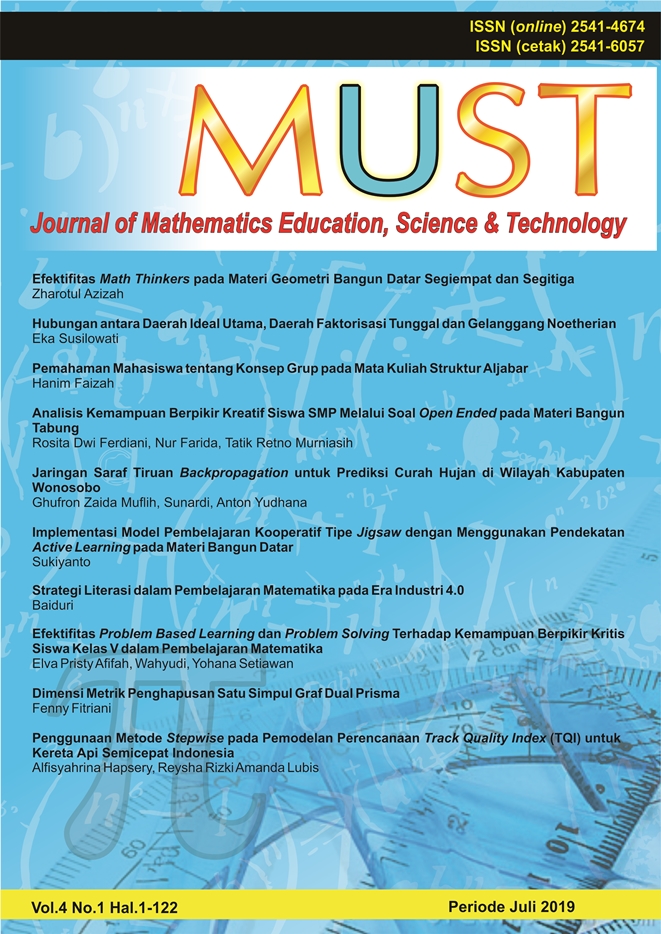Strategi Literasi dalam Pembelajaran Matematika pada Era Industri 4.0
Abstract
Full text article
References
Armstrong, A., Ming, K., & Helf, S. (2018). Content Area Literacy in the Mathematics Calssroom. The Clearing House: A Journal of Education Strategies, Issues and Ideas, 91(2), 1-11.
Atif, K. (2013). Mathematical Literacy: A Necessary Skill for the 21st Century. Retrieved from https://blogs.plos.org/scied/2013/02/11/mathematical-literacy-a-necessary-skill-for-the-21st-century/.
Bethany (2016). Using Literacy Strategies to Teach Math. Retrieved from https://mathgeekmama.com/using-literacy-strategies-to-teach-math/
Borsecnik, L., & Holzhuter, K. (2015). Mathematical Literacy and the Standards for Mathematical Practice. Retrieved from http://www.wismath.org/ Resources/Documents/Annual%20Conference/113Lborsecnik-Connecting %20Math %20Practice%20Standards%20PP.pdf.
Brown-Martin, G. (2017). Education and the Fourth Industrial Revolution. Toronto: Groupe Média TFO.
Department of Education (2003). National Curriculum Statement Grades 10-12 (General); Mathematical Literacy, South Africa.
De Lange, J. (2003). Mathematic for Literacy in B. L. Madison & L. A. Steen (Eds.), Quantitative Literacy: Why Numeracy Matters for Schools and Colleges (pp. 75-89). United States: Woodrow Wilson Natl Foundation.
De Lange, J. (2006). Mathematical Literacy for Living from OECD-PISA Perspective. Tsukuba Journal of Educational Study in Mathematics, 25, 13-35.
Devlin, K. (2000). The four faces of mathematics. Retrieved from https://www.re searchgate.net/publication/ 265740772_The_Four_Faces_of_Mathematics.
Edelman, J., & Hutchison, L. (2014). Literacy in the Mathematics Classroom in Teaching Dilemmas and Solutions in Content-Area Literacy, Grades 6-12 (pp. 81-102). Thousand Oaks, CA: Corwin.
Fang, Z., & Coatoam, S. (2013). Disciplinary Literacy: What You Want to Know About It. Journal of Adolescent & Adult Literacy, 56(8), 627-632.
Hermann, M., Pentek, T., & Otto, B. (2015). Design Principles for Industry 4.0 Scenarios: A Literature Review. Retrieved from http://www.iim.mb.tu-dortmu nd.de/cms/de/forschung/Arbeitsberichte/Design-Principles-for-Industrie-4_0-Scenarios.pdf.
Hynd-Shanahan, C. (2013). What does It Take? The Challenge of Disciplinary Literacy. Journal of Adolescent & Adult Literacy, 57(2), 93-98.
Ippolito, J., Dobbs, C. L., & Charner-Laird, M. (2017). What Literacy Means In Math Class. The Learning Professional, 38(2), 66-70.
Kenney, J. M. (2007). Literacy Strategies for Improving Mathematics Instruction. Heatherton, Vic: Hawker Brownlow Education.
Mulyani, S. (2018). Matematika Diperlukan dalam Menghadapi Revolusi Industri 4.0. Retrieved from https://kumparan.com/bandungkiwari/sri-mulyani-matematika-diperlukan-dalam-menghadapi-revolusi-industri-4-0-1538271015 315718945.
Marr, B. (2016). What Everyone Must Know About Industry 4.0. Retrieved from https://www.forbes.com/sites/bernardmarr/2016/06/20/what-everyone-must-know-about-industry-4-0/.
Martin (2017). Industry 4.0: Definition, Design Principles, Challenges, and the Future of Employment. Retrieved from https://www.cleverism.com/industry-4-0/.
Martineau, C. (2017). What is Mathematical Literacy. Retrieved from https://medium.com/literate-schools/what-is-mathematical-literacy-65775f3e5 ce3.
Moore, M. (2018). What is Industry 4.0? Everything you need to know. Retrieved from https://www.techradar.com/news/what-is-industry-40-everything-you-need-to-know.
OECD (1999). Measuring student knowledge and skills: A new framework for assessment. Paris: OECD.
OECD (2006). Assessing Scientific, Reading and Mathematical Literacy: A Framework for PISA 2006. Retrieved from http://www.oecd.org/pisa/pisapro ducts/pisa2006/37464175.pdf.
Ojose, B. (2011). Mathematics Literacy: Are We Able To Put The Mathematics We Learn Into Everyday Use? Journal of Mathematics Education, 4(1), 89-100.
PISA (2015). PISA Results in focus. Retrieved from https://www.oecd.org/ pisa/pisa-2015-results-in-focus.pdf.
Reavis, L. (2017). Literacy in the mathematics classroom. Retrieved from https://medium.com/literate-schools/literacy-in-the-mathematics-classroom-e9 7c9a2979d7.
Shanahan, C. (2012). How disciplinary experts read in T. Jetton & C. Shanahan (Eds.) Adolescent literacy in the academic disciplines: General principles and practical strategies (pp. 6990). New York, NY: Guilford.
Shanahan, C., & Shanahan, T. (2014). The implications of disciplinary literacy. Journal of Adolescent & Adult Literacy, 57(8), 628-631.
Smith, M. S., Silver, E. A., Stein, M. K., Henningsen, M. A.,Boston, M., & Hughes, E. K. (2005) Improving Instruction in Geometry: Using Cases to Transform Mathematics Teaching and Learning, Volume 3. New York: Teachers College, Columbia University.
Steen, L. A. (2001). Mathematics and Democracy: The Case for Quantitative Literacy. Princeton, NJ: National Council on Education and the Disciplines.
Steen, L. A., Turner, R., & Burkhardt, H. (2007). Developing Mathematicalliteracy. Modelling and Applications in Mathematics Education: The 14thICMI Study, 10, 285-294.
Storm, J., Catharines, S., Marseglia, A., & Lapointe, D. (2010). What Does Math Literacy Mean? Retrieved from https://www.oxfordlearning.com/What-Does-math-literacy-mean/.
Sumirattana, S., Makanong, A., & Thipkong, S. (2017). Using Realistic Mathematics Education and the DAPIC Problem-Solving Process to Enhance Secondary School Student’s Mathematical Literacy. Kasetsart Journal of Social Sciences, 38, 307-315.
TFO (2017). An Emergency for the World of Education: Adapting to the Digital Revolution. Groupe Média.
Toffler, A. (1970). Future Shock. États-Unis: Bantam Books.
UNESCO (2004). The Plurality of Literacy and its implications for Policies and Programs. UNESCO Education Sector Position Paper, 13.
Vithal, R., & Bishop, A. J. (2006). Mathematical Literacy: A New Literacy or A New Mathematics? Pythagoras, 64, 2-5.
Watson, A. (2002). Teaching for understanding in L. Haggarty (Ed.), Aspects of Teaching Secondary Mathematics: Perspectives on Practice (pp.153-162). London, UK: Routledge Falmer.
World Economic Forum (2016). The 10 skills you need to thrive in the Fourth Industrial Revolution. Retrieved from https://www.weforum.org/ agenda/2016/01/the-10-skills-you-need-to-thrive-in-the-fourthindustrial-revo lution/
Authors
Authors who publish with this journal agree to the following terms:
- Authors retain copyright and grant the journal right of first publication with the work simultaneously licensed under a Creative Commons Attribution-NonCommercial 4.0 International License that allows others to share the work with an acknowledgment of the work's authorship and initial publication in this journal.
- Authors are able to enter into separate, additional contractual arrangements for the non-exclusive distribution of the journal's published version of the work (e.g., post it to an institutional repository or publish it in a book), with an acknowledgment of its initial publication in this journal.
- Authors are permitted and encouraged to post their work online (e.g., in institutional repositories or on their website) prior to and during the submission process, as it can lead to productive exchanges, as well as earlier and greater citation of published workÂ

